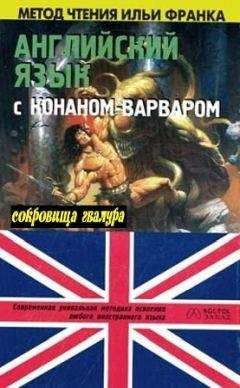Нина Пусенкова - Английский язык. Практический курс для решения бизнес-задач

Все авторские права соблюдены. Напишите нам, если Вы не согласны.
Описание книги "Английский язык. Практический курс для решения бизнес-задач"
Описание и краткое содержание "Английский язык. Практический курс для решения бизнес-задач" читать бесплатно онлайн.
Задача данного издания – познакомить учащихся с современной финансово-экономической терминологией. Первая часть книги в большей мере посвящена вопросам управления, вторая – финансовой проблематике. Темы занятий в основном соответствуют тематике курсов, которые преподаются в большинстве школ бизнеса. Уроки содержат тексты из самых разнообразных профессиональных источников и упражнения, позволяющие студентам закрепить пройденный материал. В конце учебника приводится словарь необходимой лексики примерно из 1000 слов и выражений.
Для студентов бизнес-школ, языковых, финансовых и экономических вузов, а также для всех, кто хотел бы усовершенствовать свой деловой и финансовый английский.
Source: Fortune, 1990, June 25 (excerpts)
Terms:
interviewed, delivering, manufacturer, competitive, loyal, quality, engineers, development, customer, showrooms, designs, sales, market share, competitors, focus, innovative, launched, planners
Exercise 6. Translate into English.
Когда уволенный из «Форда» Ли Якокка пришел в «Крайслер» на должность президента, компания находилась на грани банкротства. «Крайслер» обладал завидным послужным списком в области исследований и разработок, хорошей дилерской сетью и первоклассными конструкторами. Однако Ли Якокка быстро выяснил, что компания не функционировала как целостный организм. Каждое подразделение работало в полной изоляции, не поддерживая никакого общения с коллегами. В концерне было 35 вице-президентов, которые ничего не слышали о делегировании ответственности. Корпоративная структура была совершенно не рациональна – сбыт и производство автомобилей находилось в ведении одного вице-президента. При этом производственники выпускали автомобили, не интересуясь мнением сбытовиков, просто надеясь, что их кто-нибудь купит.
В компании фактически отсутствовала целостная система финансового контроля. Никто в корпорации не имел представления о том, как составляются финансовые планы и проекты. Руководство было ориентировано на краткосрочные прибыли, а не на долгосрочное процветание компании. Вместо того чтобы пользоваться своим конкурентным преимуществом – сильными инженерными и дизайнерскими кадрами, – когда прибыли стали падать, «Крайслер» начал сокращать издержки за счет снижения инвестиций в исследования и разработки.
Качество автомобилей было неприемлемым, клиенты засыпали компанию жалобами и множество автомобилей возвращали дилерам для ремонта. Доля автомобильного рынка США, принадлежащая «Крайслер», постоянно уменьшалась, а уровень верности клиентов ее автомобилям был самым низким среди «Большой тройки». Потребители воспринимали ее бренд как «скучный и чопорный». Моральный дух сотрудников «Крайслер», которые не имели представления о командной работе, также оставлял желать лучшего. (Продолжение см. в уроке 5.)
Lesson 4
Japanese Management Principles
Read and translate the text and learn terms from the Essential Vocabulary.
From JIT to Lean Manufacturing
The History of Just in Time
Around 1980 we were all just getting used to the concepts of Material Requirements Planning (MRP) and Manufacturing Resource Planning (MRPII) with their dependence on complex computer packages when we began to hear of manufacturers in Japan carrying no stock and giving 100% customer service without any of this MRP sophistication.
Japanese car manufacturers ensured that every steering column was assembled and fed onto a production line just as the car into which it was to be fitted rolled up at that particular stage. This was all managed by something called a kanban which meant «tag» and was the mechanism by which the assembly line told the feeder areas that they wanted another component. The first visitors to Japan came back to tell us that the kanban replaced MRP and was the key to Japanese success.
In time, we learned that the kanban was the last improvement step of many, not the first. The conceptual goals of minimised lead times and inventories rated above all else. The Japanese aim was having everything only when required and only in the quantity required – in other words, just-in-time (JIT).
We then learned that Toyota led the way in the development of the Japanese approach. We heard of something called the Toyota Production System which was the model for all that had happened in Japanese manufacturing. We heard of Taiichi Ohno, the production engineer responsible for this breakthrough.
The list below highlights what our Japanese counterparts had done.
1. Batch Quantities
Making something in large batches has several negative effects. The first thing which Westerners recognised was that stock levels are partly a function of order sizes. We had a formula for economic batch sizing in which the cost of set-up was offset against the cost of holding the stock. Our theoretical average stock level was half the order quantity + whatever element of safety stock we had built into our plans so reducing the order size would reduce our average stock.
There were, however, other considerations. A piece of plant cannot be immediately responsive to all demands upon it if it makes parts in greater quantities than are required at the time. Responsiveness, and hence service to our customers (whether they be external or the subsequent operations within our own plant) requires that we manufacture components in small batches.
We knew that smooth workloads make management of the manufacturing process far easier and had established smooth finished product plans with the adoption of Master Production Scheduling. However, no matter how smooth our final assembly plans, we still had lumpiness elsewhere.
The major contributor to parts being made in large batches is, of course, set-up times. Shigeo Shingo, a quality consultant hired by Toyota, had set about effectively eliminating set-ups. The accounting conventions that led Western businesses to make significant quantities of parts that may not be used were also shown to be ludicrous.
2. Safety Stocks / Quality
A major element of Western manufacturing’s inventory was that which we held in case of problems. We held safety stocks to allow us to continue manufacturing should some of the components or raw materials in our stores be found to be defective.
Ohno and his colleagues, ironically, had listened to the American quality gurus, W. Edwards Deming and Joseph Juran, who had advised Japanese industry as it recovered after World War II. Among the key concepts learned by the Japanese and neglected for many years in the West were:
Deming’s teaching that we cannot inspect quality in a product but must build it into the manufacturing process.
Juran’s definition of the internal customer. If we each give service to our internal customer then we will ultimately take care of the end customer.
By applying these teachings and aggressively eliminating all sources of non-compliance the Japanese moved quality onto a completely different plane. Where the West continued to measure percentage defect rates our competitors were working in parts per million.
As well as addressing the manufacturing processes, we learned that the JIT approach considered other contributors to improved quality. Is the component designed in such a way as to make it easy to produce or can we simplify it and reduce the chances of a defect? We began to think of «design for manufacture» and combining the previously separate functions of design engineering and production engineering.
We heard about things called «quality circles» where people in different areas of the business came together to investigate problems and work as a team to solve them – rather than follow our own approach of each area attempting to blame another. Perhaps most disturbingly we heard that inspectors were a thing of the past. All had now been trained as quality engineers and were in fact working as process improvement specialists so that their old function was no longer required.
3. Supplier Partnerships
Perhaps the most challenging concept for many companies was that of working with suppliers as partners. Buyers who spent their lives playing one supplier off against others and switching from one to another to save pennies heard that their Japanese counterparts single-sourced in nearly all cases. What is more, large corporations such as Toyota sent out their own specialists in manufacturing improvement to help their suppliers. Where savings were identified then benefits would be shared amicably.
The most readily-visible consequence of this was better service from the company’s suppliers. If we were working together on agreed plans and the supplier could arrange activities based around a long-term relationships then we might avoid a major problem that plagued us in the West – that just as we played off suppliers against each other, they played off their customers. They never knew what demand they may get so they sought more orders than they could, in reality, fulfil. They then reacted to screams and shortages and tried not to fall out too often with each customer. All of this meant all customers holding safety stock to cope with the repeated failures.
Partnership approach brought other benefits – if we worked as true partners then we would not need to spend so much effort in continuously expediting. We could leave behind this ludicrous situation where we had to keep asking «is that order going to be on time?». We could also expect our suppliers to warn us of problems in advance. If their key piece of plant broke down and they told us now of the impact this might have in a week or two, then we could set our own plans to work around the problem.
4. The Elimination of Variety
Variety was recognised for its cost in that it complicated the manufacturing process. A sunroof on every Toyota Corolla was not only a marketing trick but a practical manufacturing improvement as having to make two different types of roof and two different types of headlining introduced potential problems.
5. Shortened Cycle Times
One point which we all understood was that our overall cycle times for our product dictated the level of work-in-progress (WIP). If we have an average lead time of four weeks for the components going through our welding department, then we will have an average WIP level of four weeks’ worth of production.
The Japanese had addressed this in a number of ways, primarily in a fundamental redesign of factory layout and process flow. We learned that rather than have one area of the plant for presses, another full of lathes, another drills, and so on, they had switched to «focussed factories» where each area of the plant made a particular type of component. The unit making drive shafts had saws, followed by milling, turning, drilling and so on. These focussed units then brought the opportunity for multi-skilling and teamwork which helped to provide for productivity improvements – as well as significantly reducing the movement of materials through the factory.
6. «Pull»
The kanban was then the final piece in the jigsaw. One of the major benefits of kanban is that it is very simple; it is also quite visible to all concerned and its logic is clear. It worked when all the issues preventing immediate response had been addressed and was the mechanism by which a build up of stock could be prevented. The yellow card attached to the container, or the floor space between two work benches, was the signal to initiate production of more of the item. If the assembly line stopped, then the subassemblies ceased being used and no more signals were generated. This contrasted markedly with the position in Western plants where an assembly line problem quickly led to a massive pile-up of inventory with items being mislaid and damaged.
Culture
Few of the Japanese ideas for change in manufacturing were totally new. Frederick Taylor and Henry Ford had promoted many of them at the start of the 20th century. Where the Japanese did have much to teach us was in the total commitment of everybody to these new ways of working. We began to hear of stock levels being reduced to the point that every slightest problem immediately caused a major hold up, and this was actually treated as a reason for celebration. «A problem is a pearl, «we heard, meaning that finding a problem in a process was a good thing. Why? Because the problem was there and we didn’t know about it, but now we do, so we can fix it.
The Move to Lean from JIT
As we understood more of JIT we learned that stock levels and lead times were not the only targets of the Toyota Production System and its followers in Japanese industry. We began to realise that our aim must be to eliminate waste in all its forms. «What is waste?» we asked ourselves, and turned to people like Mr Ohno and Mr Shingo and were told that «waste is anything which does not add value.»
We knew already of some wastes – for example, inspection adds no value. Why not just get the process right and then we needn’t carry out this activity? Similarly, why expedite our suppliers when, if we had chosen good partners and had a true partnership with them, this would not be needed? Why move items to a dedicated packing area if we could perform the packing in tandem with the assembly operation for the product and eliminate this movement? Why move parts from one end of a factory to another, and back again, if a little more thought in laying out the plant differently might take out this activity?
So, JIT became Lean when it was recognised that parts arriving only when required and only in the quantities required is only a part of the story.
Source: www.training-management.info, Ian Henderson
Essential Vocabulary
1. Material Requirements Planning – планирование потребности в материалах
2. Manufacturing Resource Planning – планирование производственных ресурсов
Подписывайтесь на наши страницы в социальных сетях.
Будьте в курсе последних книжных новинок, комментируйте, обсуждайте. Мы ждём Вас!
Похожие книги на "Английский язык. Практический курс для решения бизнес-задач"
Книги похожие на "Английский язык. Практический курс для решения бизнес-задач" читать онлайн или скачать бесплатно полные версии.
Мы рекомендуем Вам зарегистрироваться либо войти на сайт под своим именем.
Отзывы о "Нина Пусенкова - Английский язык. Практический курс для решения бизнес-задач"
Отзывы читателей о книге "Английский язык. Практический курс для решения бизнес-задач", комментарии и мнения людей о произведении.






















